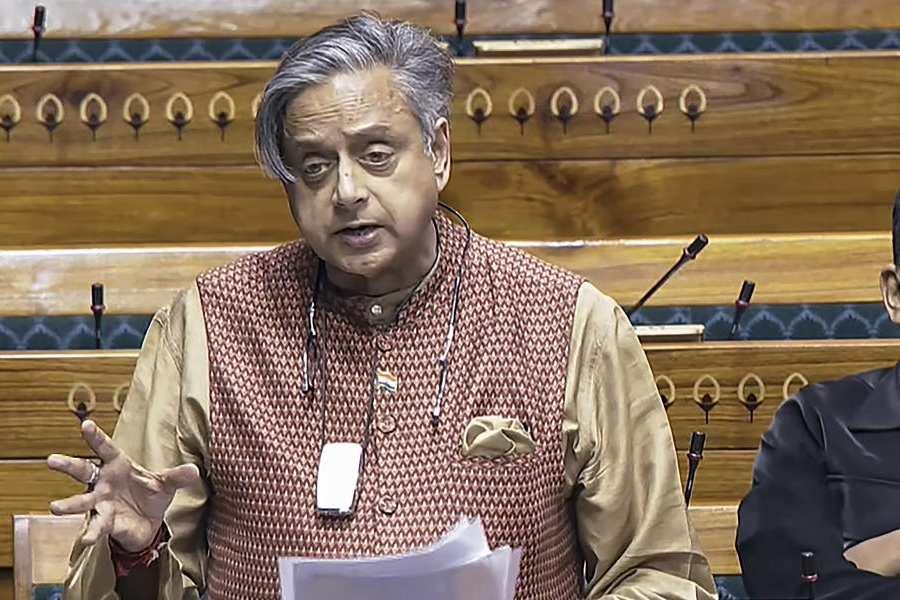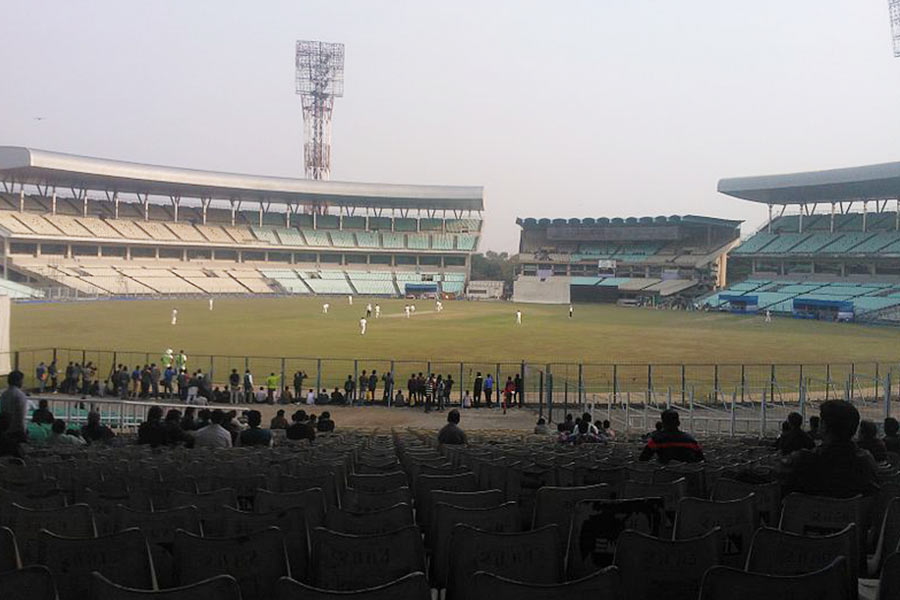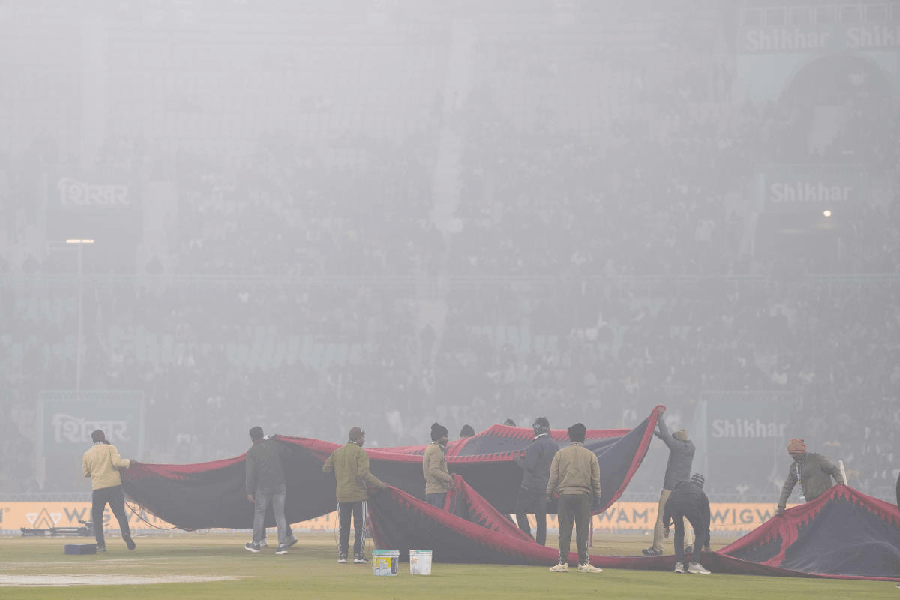 |
Anirban Lahiri loves luchi and alur dum as much as the next Bengali. “But I probably eat it only once a year,” he reveals. For the sake of his golf, Anirban has had to make many a sacrifice. At 25, he is one of the best young golfers in the country and still going places.
Currently, the professional golfer is experiencing “the lull after the storm — the whole week was such a whirlwind”.
He is referring to his dream debut in the British Open at Royal Lytham & St Annes where he achieved a 150 yard “hole in one”.
Playing at such a traditional golf course, established in 1897 and one of the most exacting in the world, is “like making your debut at Wimbledon”, says the two-time Asian tour winner. “Or it’s like making a debut in the Ashes in the final Test.”
And the hole in one?
“Let’s say the odds of anyone making a hole in one are one to a million,” he estimates. “It is like getting a royal flush playing poker.”
And, yes, he admits his heart did beat a bit faster. “Oh, absolutely I was really, really nervous and excited at the start of the event but as I played through the week, it got better and I got more confident and more positive.”
He is sure the experience will help him as he plays more top tournaments in Asia, Europe and America this year.
As always, Lahiri wore a green shirt — “green is probably my favourite colour but I like wearing bright colours, anyway. Given the English summer and its unpredictability, it helps to wear bright colours.”
The ball he hit has been bagged by his father, Tushar Lahiri, who introduced his son to golf “18 years ago” when Anirban was 10. “I started playing at eight. Dad Introduced me to the game. He still plays for leisure. It started in Ganganagar when Dad was posted there.”
Lahiri doesn’t find his father’s presence a distraction. “I have a fantastic relationship with my father and he is more of a friend than anything else,” the world No. 226 says.
Belonging to an army family meant Lahiri has had access to the services’ golf courses. However, his schooling was never in one place. “My dad, who is still a serving doctor with the Indian Army, gets transferred every couple of years from one cantonment to another,” he explains. “We pretty much moved around all over India.”
His life has been itinerant: he was born in Pune, and then moved to Secunderabad. “Then we moved to Roorkee, then we moved to Ganganagar, then we moved to Binnaguri, then we moved back to Secunderabad. That’s where I finished my schooling.”
After graduating in commerce from Bharatiya Vidya Bhavan in Hyderabad, Lahiri settled in Bangalore where today he lives on his own. His mother, Navanita, stayed back in Hyderabad while his father carried on with postings in Chandigarh and Nagpur.
He is proud of his Bengali identity. “I am Bengali on both sides; I speak Bengali, I can read a little bit, I write a little bit. But since I have grown up all over the country and in varied cultures, be it north or south Indian, I am more Indian than Bangali. I am more of a probashi. I am as comfortable speaking Punjabi as I am speaking Bengali as I am in English.”
Occasionally, his mother visits him for a couple of days.
“I let her indulge me, but strictly no sweets,” he laughs. “I have to stick to my cereals and my honey and fruits and yoghurt and things like nuts and berries.”
He has heard of horror stories from Calcutta. “A lot of people have rice for breakfast. That is a big no for me. If you look at how often people will have luchis and alur dum... that is harakiri for us (sportsmen).”
Since he travels so much, it is often more a question of what not to eat. “Instead of chips you might have mashed potatoes or instead of having deep fried you will have grilled.”
Maybe he and Sourav Ganguly should become Bengali food policy advisers to Mamata Banerjee.
“You have to regulate your carbohydrate and fat intake,” advises Lahiri. “I don’t think there is much regulation if you look at a Bengali diet. Half of Bengal is suffering from either sugar or (blood) pressure.”
Incidentally, Lahiri corrects a Wikipedia entry that he is 6ft 1in (1.85m). “I am 5ft 9in.”
He is contracted to use clubs made by the Japanese firm, Srixon. They are probably a bit like him — “very precise instruments but strong and durable”.
Behind his hole in one at the British Open is a strict work routine. “I leave home at 7 in the morning and I come back at 6 in the evening. I practise in Bangalore at a place called the Touché Golf School.”
The day consists of golf, golf, golf and more golf. “My trainer is there, so yeah, it’s a full day’s work.” He says the life of a golfer looks very glamorous on television “but there is a lot of work that goes into it”.
Sure, for a successful golfer, “the money is there but you have to be really good to get to the money”.
He tries to lead as normal a life as possible. “I have a whole bunch of friends who I go out and have fun with.”
And he gives himself an occasional break from his rigorous training, “so you don’t kill yourself doing it but you have to understand how to give yourself a break. Going to KFC and having a bucket of chicken is not a good break.”
But he wouldn’t be doing what he does unless he loved golf. “There has to be an element of work. But I think there is more passion and more love in doing what I do than compulsion.”
So, Lahiri, what is the charm of hitting a ball, perhaps into a stream or a thicket or into deep sand?
“If somebody hasn’t played golf and is watching golf only on television, he will not understand it until he has actually hit a golf ball. But I can vouch for every golfer on this planet that it is the most addictive game in the world,” enthuses Lahiri .
“Golf is a big reflection of life,” he goes on. “Every time you try and hit the golf ball it is a reflection of something you want to do in life the right way, the perfect way. Everybody is still looking for the perfect shot... it is so elusive and so fleeting. When you do actually manage to get it, it is a high that is beyond description.”
The coaches take care of the technical aspects of the game but the best players have a deep understanding of why a golf ball has more dimples than Preity Zinta, for example.
“That is the physics aspect of golf,” says Lahiri patiently. “It’s a very science and research-driven sport. For the ball to stay in the air longer and for it to hold on to its line better, it needs to spin at a certain rpm — revolutions per minute. If golf balls didn’t have dimples, they wouldn’t be able to hold up in the air long enough — they would spin out too quickly.”
He is pleased that golf is picking up in India. “There are lots of kids, lots of girls, who are very, very enthusiastic about the game and are playing well even on a global stage.”
He acknowledges his success will inspire a new generation, “just like we were inspired by Jeev Milkha Singh (who won the Scottish Open and also played, though less successfully, in the British Open) and Jyoti (Singh) Randhawa and Arjun (Singh) Atwal who have been our role models”.
Well, Lahiri, when it comes down to it, what’s the difference between you and, say, Tiger Woods?
His response is matter of fact.
“Well, not much.”
What he means is that his European and American counterparts have benefited from a superior infrastructure. “We play golf in a very protected and very limited environment. They have great infrastructure and support facilities. The second thing is that the standard of golf (in the West) is high because the level of coaching is very good as well. The amount of funding and corporate sponsorship out in the West is so high that it encourages a lot of young guys to work harder and get more involved and interested in sports. It is a cycle that we are a little lagging in but I am sure we are on the right path.”
He comes across as a thoughtful and modest young man.
And it is certainly encouraging to hear that Lahiri is optimistic about golf — and about the new India. “I have now travelled widely over Europe, Asia and a couple of trips to Africa as well, and obviously we do have a long way to go. But I feel really connected to home and I love the people and I love everything back home. We do have our shortcomings with our politics and with cleanliness and population and the corruption — we do have issues, every country does. But every time I come back home when I go to sleep at night I feel glad that I am back. Home is home.”










